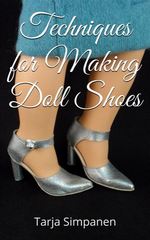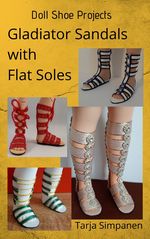I am sure that I will try to find better silicone for the next time, if there is going to be a next time. Rai-Ro web shop sells two component silicone, which sounds promising. That one is mixed 1:1 and that should make things a lot easier.
Let's move on to the main subject of this post, casting the soles. The picture below shows the casting resin I'm using. Those bottles had these childproof caps that you need to press and turn. Bad idea. The bottles were made of very soft plastic and it was impossible to get the caps open. I ended up cutting the bottles open and pouring the contents into two small airtight containers.

Before starting, I made two openings in the moulds, one to pour the resin in, another one to let the air out. After several unsuccessful attempts, I realized that for some reason, air wasn't getting out as planned. That's when I made the third opening at the bottom of the heel and cast the first complete sole. So, you need three openings as shown in the picture below.

Treat the forms with the form separating agent and let it dry before closing them for casting. I used small clamps to keep the halves of the mould together. Sturdy pieces of cardboard on both sides of the mould distribute the pressure evenly. The clamps should not be tightened too much, just enough to keep the mould halves together. If you tighten the clamps too much, the mould may get distorted.
Pour in a little resin through the opening in the toe part, turn the mould carefully back and forth to spread the resin and let the air bubbles out (tap the mould lightly to loosen any air bubbles), pour in more resin, turn again, and continue until the mould is full. You can see it is full, when the surface of the resin rises to the middle opening, which is in the highest part of the mould.
You probably won't have much time for all this as the resin starts hardening fairly quickly (check the instructions of the resin you're using). Mix small batches of resin and work with one or two moulds at a time.
Measuring the correct amount of resin is difficult with something this small. We're talking about milliliters here and there is always going to be a little extra mixture, no matter how carefully you measure. This is where a mould for a wedge sole becomes handy.
I made a mould for a wedge sole, because you can leave a large opening in a mould like that. When you have filled the mould you're working with and there's a bit of resin mixture left, instead of just letting it harden in the mixing bowl, pour it in the wedge sole mould. It may not fill the mould entirely, but as you cast several soles and pour the extra in the wedge sole mould, you're going to end up with a wedge sole eventually. The structure of the mould makes it easy to fill the mould a little bit at a time instead of filling it all at once. And even if the resin is already starting to get a bit thicker, it can still be poured into an open mould like this.
Here is a little video clip showing some of what I have explained above.
You should remove the cast sole from the mould as soon as it is solid. At this stage, it is still soft and it will be easy to cut off all extra resin. Remove the sole from the mould, cut off the protruding pieces where the openings were, wash the sole (to remove any remaining form separating agent), and cut off any extra resin, for example, in the seams. Then check that the shape of the sole is correct, for example, that the heel is straight, and let the piece harden as long as is needed to achieve final hardness.
The instructions of the casting resin said that it can't be stored very long after the bottles have been opened, so I decided to use it all at once. The picture below shows the cast soles that are good enough to use for shoes. Some of them have holes left by air bubbles, but those can be filled in and covered. Mostly these are for Sybarite's shoes. Most of the small soles are for Silkstone Barbie and Fashion Royalty shoes, but the ones on front left are for Tonner's Tiny Kitty Collier. The individual heels and toe parts on the right are for Tonner's American Model. The transparent yellow soles are made of E-Z Water plastic using the wedge sole moulds.

Earlier posts on the subject:
Mould Making: Making a master
Mould making: Silicone
Mould making: Problems with silicone
For the Finnish post, see here.





5 comments:
Love seeing all those cast shoe soles!
Any information on what kind of die cut machine i can use for the sole's of American Girl dolls
thank you,
Stella t.
Hi, I would like to purchase the soles for FR, do you sell them?
Rosanna, I don't sell the soles I have made as they are for my own use, at least for now.
im having a really hard time finding glue that holds fabric to shoe soles of any kind! plz help... shanasfashions at gmail
Post a Comment